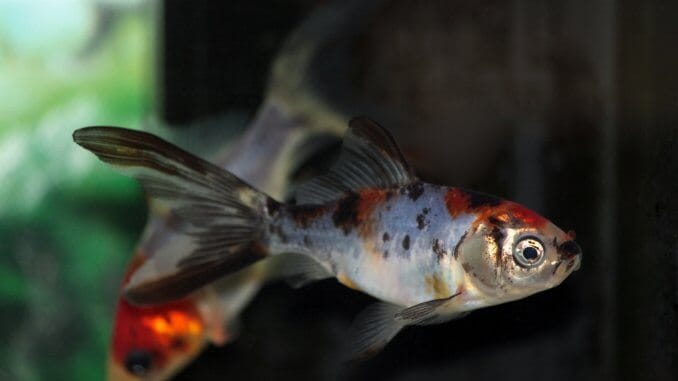
Goldfish are one of the most popular fish in the aquarium, especially for beginners.
The shubunkin goldfish looks like the comet goldfish but brings extra color and flair to the tank with its longer more flowing fins and blue coloring.
Their pretty appearance means they can be used to brighten up any fish tank or pond.
Shubunkin goldfish are also very hardy and are known to be extremely adaptable and able to survive in most situations with a wide variety of food.
TABLE OF CONTENTS
Shubunkin Goldfish Facts & Overview
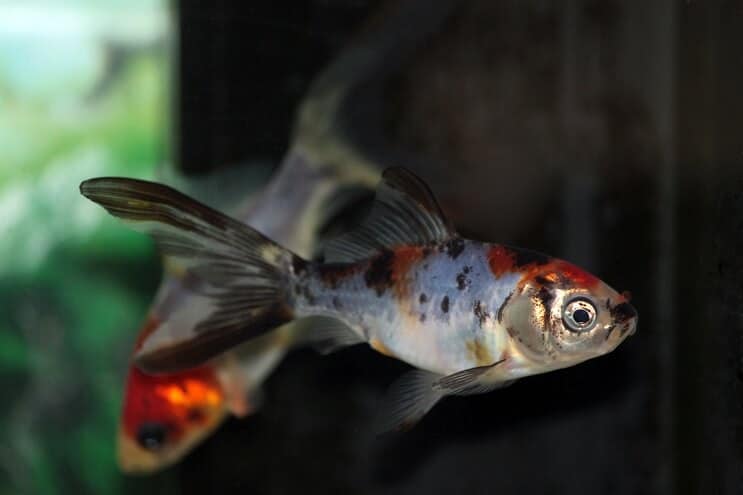
| Category | Rating |
| Care Level: | Easy |
| Temperament: | Peaceful |
| Color Form: | Calico |
| Lifespan: | 15 years |
| Size: | 12 inches |
| Diet: | Omnivore |
| Family: | Cyprinidae |
| Minimum Tank Size: | 75 gallons |
| Tank Set-Up: | Planted freshwater |
| Compatibility: | Other peaceful fish |
The shubunkin goldfish has become popular because of its coloration. They belong to the Cyprinidae family, just like common goldfish, carp, and danios. They have several shared characteristics including not having true teeth but a few rows of pharyngeal teeth, located in the throat.
The coloration, calico, is also the reason these fish go by the common name calico goldfish; however, their scientific name is Carassius auratus.
Calico refers to a multicolored or mottled animal. You may have heard the term ‘calico cat’ and it is much the same.
Like many goldfish, they make amazing additions to indoor aquariums and outdoor ponds. They are at home in colder waters which means they are ideal for ponds. Their colors can even resemble the more expensive koi which makes them ideal to create a stunning pond on a budget.
If you are looking to get the most out of your fish, then making sure they have enough room to grow will allow them to live for many years to come. Therefore, having a pond is the best habitat as it will give them space to grow however it is not mandatory.
You can also keep these fish inside if the tank is very large with plenty of room (more on this later).
Typical Behavior
These fish are extremely social and will make amazing additions to community tanks full of other fast-swimming fish. The reason for this is that these goldfish are extremely fast swimmers and will eat as much food, as fast as possible.
You will likely see them around the bottom of the tank eating whatever they can, making the addition of other scavengers unnecessary.
Appearance (Blue, London, Bristol, and American)
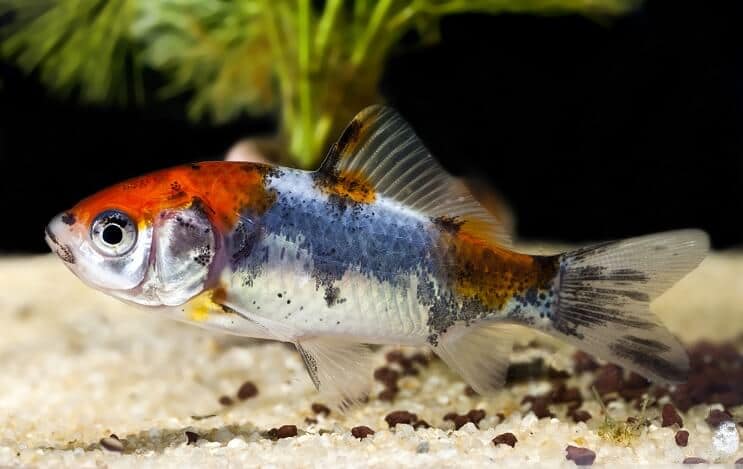
These fish come in many different patterns, all with calico coloration. When you hear the word “calico” you probably think of the cat. The reason for the color is all to do with genetics.
Shubunkin goldfish have a spotted color, which is usually a combination of red, yellow, orange, white, black, and blue.
They also have long-flowing fins that add to their appearance. As they swim you will see these fins flow with their movements and look beautiful.
The most unique characteristic is the blue coloration that some calico goldfish can have. This blue is incredibly rare and helps to determine the price of these fish. The bluer a fish, the rarer and more expensive it is.
There are three different types of shubunkin goldfish depending on how you classify them:
- The London
- The Bristol
- The American
The London goldfish will have a varying coloration (but still with the calico pattern). The fins will be more rounded and the body more slender.
The Bristol goldfish has more of a slender body, like a comet, but has a distinctive tail. They also have larger, more pointed tail fins.
Finally, the American goldfish is also distinguished by its tail. They will have a long pointed tail with a much deeper fork. It is believed that this type, also referred to as the Japanese shubunkin, is the original variant instead of a different type.
Habitat and Tank Conditions
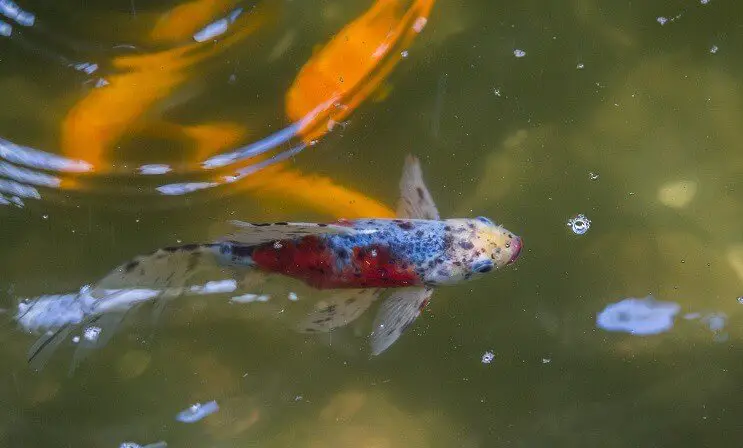
The goldfish you see in stores today are descendants of wild carp from Asia. As a member of the Cyprinidae family, they prefer to live in slow-moving, lakes, rivers, ponds, or ditches. Here they feed on plant material, detritus, small crustaceans, and insects.
These wild carp were not as colorful and today’s goldfish have been bred to bring out the different patterns and bright colors. This breeding has not lost the nature of the fish though; their behavior and dietary needs are very similar.
They can live up to 30 years and grow to over 12 inches. Conditions must be near perfect for this to happen; meaning lots of food and space.
In an aquarium setting, your fish are likely to live for around 15 years if you keep their tank or pond conditions good. The size of your fish will depend on the space they have and how much food they consume.
Tank Conditions
In order to keep your goldfish healthy, make sure you have a tank with plenty of room for them to move and search for food.
There should be low to moderate water movement and a good amount of light. Keep the water itself as stable as possible to avoid stressing your fish however goldfish are hardy and will tolerate change better than other fish.
- Temperature: 65-72°F
- pH: 6.0-8.0
- Hardness 5 – 19 dGH
For substrate, most will work for these fish. Medium size gravel is best as it allows them to sift through the gravel and find bits of leftover food and other materials.
Having a good filtration system is important as these fish are incredibly messy. Frequent water changes are also important to keep the water clean and the fish healthy.
Plants can be hard to keep with goldfish as they may be eaten. Even the ones they do not eat may be uprooted in their constant search for food. If you do want to keep plants, consider fast-growing species such as Java fern, anacharis, and hornwort.
What Size Aquarium Do Shubunkin Goldfish Need?
75 gallons is the minimum size needed for shubunkin goldfish. Because these fish are such fast growers, the bigger the tank the better.
How Many Shubunkin Goldfish Can Be Kept Per Gallon?
Make sure to not overcrowd your tank by only having 1-2 fish per 75 gallons.
Tank Mates
The first thing to know about tank mates is that these fish are very active and will steal food from other fish. This means that slow-moving or shy fish will not make the best tank mates.
Tetras, guppies, killifish, glass catfish, and cherry barbs all can work alongside the shubunkin goldfish. Because they are so active and fast-moving while feeding, you may have to watch and feed your fish at different times and in different areas to allow for each fish to eat properly.
Do this by feeding your Shubunkin first on one side of the tank, then switch to the other side to let your slower fish enjoy their food.
While it is possible to add more shy and peaceful fish, it adds a level of complexity that some people may not yet be ready for.
If this is the case for you, add other species of goldfish or koi to your tank. Fancy goldfish, comet goldfish, and koi will all have the same attitude and temperament. They also have the same general colors with lots of variation which makes them look great together.
If you are thinking of adding any crustaceans or other invertebrates, then you are in luck.
Pick larger, peaceful invertebrates such as amano shrimp or mystery snails. Avoid smaller creatures like cherry shrimp and ghost shrimp who may be mistaken for food and eaten.
Make sure to avoid overly aggressive fish such as cichlids or tiger barbs as they will attack and eat your fish.
Diet
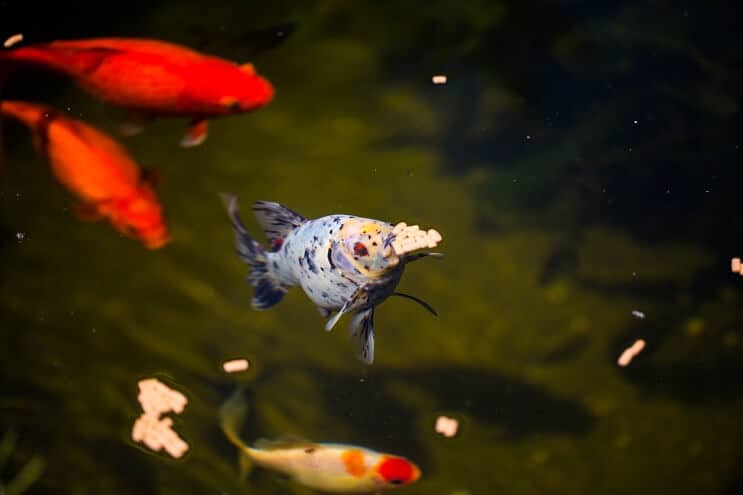
It can be hard to say what these fish ate in the wild due to them being a captive created and raised species. However, if we take a look at their carp ancestry, it is likely that they ate whatever they could: plant material, small insects, or scraps of detritus.
Goldfish feed on plant material, detritus, small crustaceans, and insects. They actively search the bottom and middle of the water column for anything they can fit in their mouth.
The best part about this behavior is the fact that you will not need to have scavengers in your tank. Your shubunkin goldfish will do most of the cleaning for you.
The bad part is that goldfish may uproot or eat plants in search of food. This is the reason that certain plants like lilies or fast-growing species go well with goldfish.
Because of their nature, you can get away with feeding them a wide variety of food. Most people use pellets which will give them the nutrients that they need. Use pellets or flakes as their daily staple food and feed them as much as they can eat within two minutes, twice a day.
They are omnivorous so will enjoy a combination of both plant-based foods and meaty foods. As a treat once or twice a week you can give them vegetables from your kitchens such as cucumber or blanched greens.
You can also feed them live or frozen foods such as brine shrimp, daphnia, blood worms, and tubifex worms.
Care
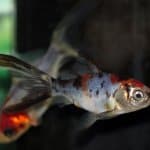
Like any goldfish, the shubunkin is extremely messy. This means that you will have to perform water changes and clean your tank more often than other species of fish. This is not too much of a problem but can be time-consuming.
You must do everything you can to keep your tank clean to avoid parasites and bacteria, perform a 25% water change every one to two weeks.
Along with the other main fish diseases, keep a close eye on your fish’s skin for a specific disease called ich; this is the most common goldfish disease in aquariums.
Ich is a parasite that shows itself in white spots on the surface of your fish. The first sign of this parasite is your fish ‘scratching’ itself on its surroundings. If left untreated, the white wounds can lead to bacterial and fungal infections. Your fish will become lethargic and eventually die.
The good thing is, this is treatable. There are several products available to add to your tank that will help get rid of the parasite. Isolating sick fish is always important so sickness and disease don’t spread.
You should also watch out for is swim bladder disease. If you see your fish swimming sideways, floating, or it is bloated then a buoyancy problem may be the case.
Another big problem with these fish, especially with their large fins, is fin rot; a bacterial disease caused by poor water conditions.
Keeping the tank clean, and your fish happy and calm, is the most effective way to prevent any disease. When fish are stressed they can become susceptible to illness.
There are plenty of commercial treatments for these diseases, but the best medicine is prevention. Most, if not all, illnesses can be prevented through proper water control and weekly monitoring of the water parameters.
Breeding
Shubunkin goldfish were likely first bred in Japan from carp and are now one of the 125 goldfish species traded worldwide.
They will breed in groups of at least 4 or 5. They are very sociable animals and prefer to shoal in larger groups.
Shubunkin will spawn in the right conditions which means if you make sure the tank conditions are perfect, the fish will breed without any other intervention.
To start the breeding you first need to have a separate tank set up; also called a breeding tank. This tank should be full of plant life to help with the spawning and to catch the eggs. Artificial plants will also work just fine.
In order to get your fish to spawn, slowly drop the water temperature to around 60°F. Then begin to warm the water by 2-3°F per day until you reach around 72°F. Goldfish breed in warmer waters so this should stimulate them to be ready to spawn.
Feed them lots of high-protein foods like brine shrimp or bloodworms. Ensure that there is not too much left-over food as it will sit at the bottom of the tank and make the conditions harsh on the fish.
Males may start to chase the females, non-aggressively, for a few days and their colors will begin to darken and intensify.
The males will then push the females against the plants which causes the females to release eggs for the males to fertilize. Spawning can last a few hours and produce up to 10,000 eggs. Once spawning is done the parents will begin to eat any eggs that they can find. For this reason, the adults must be removed. It will take around 7 days for the eggs to hatch.
Feed the fry small food until they are large enough to eat brine shrimp or other larger food. Once they reach about one inch they can be added to the adult tank.
Are Shubunkin Goldfish Suitable for your Aquarium?
Shubunkin goldfish make excellent fish for both beginners and advanced aquarists.
They can fit into many community tanks as well as outdoor ponds. There is plenty of fish that will work well with them and keeping this fish will provide you with an energetic and active species.
No matter your level, you can find a benefit to these colorful and hardy fish. There is little to watch out for except for keeping the water conditions stable.
They add so much to your tank and can even be additions to ponds as an alternative to koi. If you have a large enough tank or pond for these fish, then they could be the fish for you.

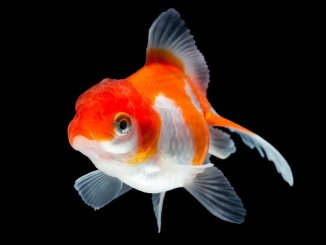
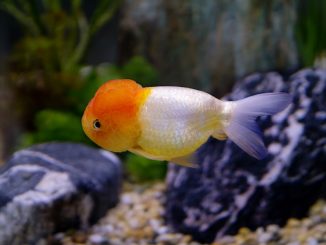
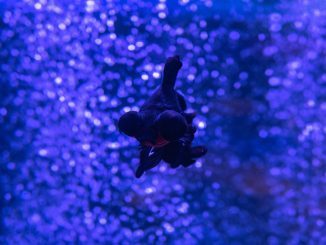
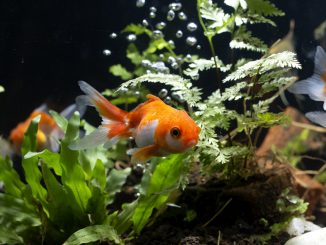

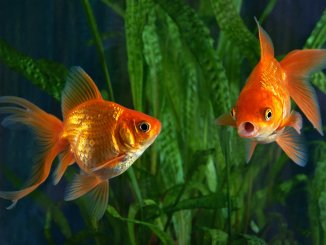
No I have not ever owned Shubunkin until this past year. 5 months to be exact. I used to keep fancy goldfish, particularly Oranda but got discouraged when they ended up with bladder problems. I used to have comets and decided to back to them affer I lost my 5 yr old Oranda. Last November I lost my 7 yr old, 14″ 1.49 lb Sarassa. I have another comet approximately the same size now and wanted to give him company but couldn’t do it until spring and storws got their stock in. I decided to get Shubunkin. I bought 2 babies, 2″, lost one and now he’s almost 4″ now. I thrn purchased another onr from Koi World. He was 8″ and was dwarfed by my comet but he’s catching up now. I am very happy with them too. I find them to be very personable, active and friendly. More so than my comet which I’ve had now for 3 yrs. The 8″ is called Dean and the 4″ is Kevin. Both have beautiful finnage but Dean still needs to grow part of his damaged caudal fin. They grow sliely but it’s coming along.
Quick question. Am transitioning a reef tank to freshwater. 250 gal with sump. What type of flow rate is comfortable for these fish. I have two existing 1800 gph submersible pumps currently but while this will help with water quality, is it too high a flow rate and will stress the fish (probably 3-5 fish, no more)
Hello, around 10X the size of your tank is flowrate you need per hour for Goldfish, so you might find your current setup too powerful. The fish should be able to swim again the current and in the area around the output, or the rate is too much. Thanks, Robert
Keep shrubs koi and goldfish in pond and aquarium
Works really well
29 years now
I have a small (35 gal) prefab pond. I have 5 goldfish: 1comet, 2 surassa comets, and 2 shubunkins. His is a still pond with no filtration or pump. I have had it for many years. I have hornwart and water hyacinth floating. Surprisingly, my water stays very clear, the fish are healthy. I love the shubunkins, but I do think they ate all my japanese pond snails which was a bummer. My fish arent super big. Just thought it might interest you that this sort of setup is successful
I have 8 Shubunkin goldfish in an outside 750 gallon pond in Houston Tx.
They do well, my problem is to stop them breeding! Every spring when pond is cleaned at least 10-25 3” fish have to be deported to a retirement pond. My pond only supports the 8 who are about 10” long. They are 6-9 years of age. Plenty of weed in pond, fed when temp above 55F.
Hi, thanks for the great website and information!
My husband and I recently acquired a small pond (approx. 30 gallon) for our garden. We’ve added 2 water lilies and 6 Shubunkins. It has a waterfall for oxidation, but no other pump or filter.
We’ve noticed that 3 of the 6 have grown much bigger than the other 3 in just a few weeks (1 month since purchase, all from the same tank), especially the 1 which is now the smallest and hasn’t shown much growth in total.
We feed them twice a day and I make sure to spread it all over the pond surface to give them all a fair chance. But this 1 doesn’t really seem all that interested in eating after the first few bites and usually goes and “hide” under the waterfall.
I’ve found this very interesting and thought you might have an idea as to why their growth rate is so much different.
Thanks and stay safe :)
I bought 2 Shubunkin, both were about 2” long in October one is now 5” long and big bodied, the other is about 3 1/2” long and small bodied. The larger one will chase the smaller one around the tank, but never hurts the smaller one, but most of the time they are laying on the bottom of the tank side by side. My question do I have a male and female ? We live on a golf course in Florida and are snow birds, in the past I’ve had koi’s and when we get ready to leave to go up North I put the koi’s in the pond behind our house, we’ve had some that have grown to about 24” long, and seem to love their environment, they do not get fed but seem to thrive with what the pond offers for food. Can I put the two Shubunkin’s in the pond with the koi’s ?
Hi I have a pond with 5 shububkins and 3 blue orf. Last year my Shubunkin bred and the result was a number of fry that were eaten but one survived but is completely black. Will it change colour? It has increased in size and has the same shape and fins as the other Shubunkins? It is nearly a year old. Thank you
How do you know Male or female and do they have a barb under their as 1 of mine got caught in a net when cleaning the pond
will the shubunkins and comets cross breed?
Hi I just have a simple question, how may young shubunkin goldfish can you put in a 30litre/7 gallon tank? Thanks
I would recommend 1 or 2. Goldfish enjoy having friends so that’s the only reason I put 2. Keep in mind that goldfish will stop growing in a small tank, but that does not mean you should do it. If you keep your goldfish in a 7 gallon for a year they will not be able to grow bigger. If you have a 7 gallon to water changes every 1-2 weeks and have a good strong filter.
I was pleased to see my 3 Shubunkins, Dot, Bettleguise and Sol. Survived a MI winter in my back yard pond. It’s 4′ deep in one end.